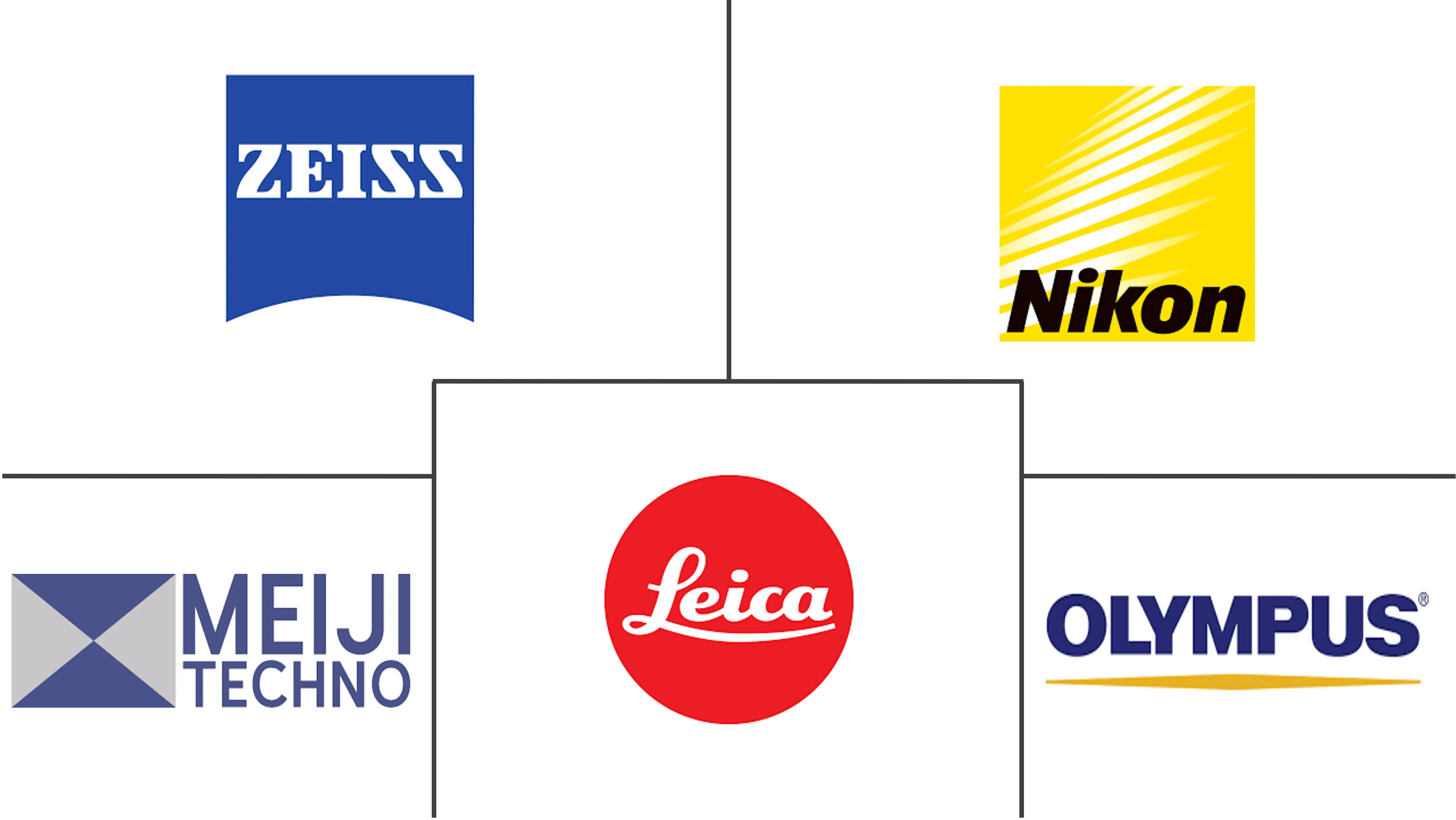Optical Microscopes Market Size and Share

Optical Microscopes Market Analysis by Mordor Intelligence
The Optical Microscopes Market size is estimated at USD 2.92 billion in 2025, and is expected to reach USD 3.88 billion by 2030, at a CAGR of 5.83% during the forecast period (2025-2030).
Machine-learning algorithms now automate image acquisition and interpretation, cutting analysis times from hours to minutes and allowing laboratories to cope with mounting sample volumes. Quantum-sensor integrations are pushing spatial resolution to 10 nanometers, opening new investigative windows in molecular biology and nanomaterials research. Funding inflows particularly the National Institutes of Health’s shared instrumentation grants underpin robust upgrade cycles in academic and clinical facilities. Meanwhile, democratized fabrication such as fully 3D-printed optical assemblies priced below USD 50 has begun to lower adoption barriers in resource-limited settings.
Key Report Takeaways
- By product, digital microscopes captured 36.92% of the optical microscopes market share in 2024 and fluorescence & super-resolution systems are expanding at a 7.56% CAGR through 2030.
- By end user, academic and research institutes accounted for 42.81% of 2024 demand, while diagnostic laboratories are set to grow the fastest at an 8.81% CAGR to 2030.
- By geography, North America led with 34.13% revenue contribution in 2024, whereas Asia Pacific is projected to post the quickest regional advance at an 11.09% CAGR.
Global Optical Microscopes Market Trends and Insights
Drivers Impact Analysis
| Driver | (~) % Impact on CAGR Forecast | Geographic Relevance | Impact Timeline |
|---|---|---|---|
| Rising Funding for Life-Science R&D | +1.2% | North America & Europe | Medium term (2-4 years) |
| Digitization & AI-Enabled Image Analytics | +1.8% | North America & Asia Pacific | Short term (≤ 2 years) |
| Surge in Nanotechnology-Driven Microscopy Demand | +0.9% | Asia Pacific, spill-over to North America | Long term (≥ 4 years) |
| Growth of Clinical Point-of-Care Microscopy | +1.1% | Emerging markets worldwide | Medium term (2-4 years) |
| Open-Source Hardware & 3D-Printed Optical Components | +0.6% | Academia globally | Long term (≥ 4 years) |
| Lab-on-Chip / Microfluidic Integration | +0.7% | North America & Europe, expanding to Asia Pacific | Medium term (2-4 years) |
| Source: Mordor Intelligence | |||
Rising Funding for Life-Science R&D
Federal and philanthropic programs are underwriting next-generation imaging facilities, such as NIH’s USD 130 million cryo-EM expansion and Princeton University’s endowment-backed optical core upgrades.[1]Eric Hand, “‘We need a people’s cryo-EM.’ Scientists hope to bring revolutionary microscope to the masses,” Science, science.org Grant mechanisms favor shared-use models, elevating utilization rates and steering procurement toward versatile, modular platforms. Higher capital availability particularly benefits fluorescence and super-resolution instruments whose premium pricing aligns with advanced biomedical use cases. The optical microscopes market therefore locks in multi-year order visibility across academic consortia and regional research networks.
Digitization & AI-Enabled Image Analytics
Deep-learning pipelines now equal or exceed expert pathologists in tumor grading tasks, enabling microscopes to deliver actionable insights in near real time. Frameworks such as ATOMIC demonstrate zero-shot material characterization, removing pre-trained model bottlenecks and widening industrial applicability.[2]Jingyun Yang et al., “Zero-shot Autonomous Microscopy for 2D Materials,” arXiv, arxiv.org Edge computing embedded directly into camera sensors slashes latency, and adaptive illumination guided by AI reduces phototoxic exposure by double-digit percentages. As a result, the optical microscopes market sees escalating demand for integrated hardware-software bundles rather than standalone optics.
Surge in Nanotechnology-Driven Microscopy Demand
Single 5-nanometer quantum-dot detection via photothermal microresonators and structured-illumination mid-infrared photothermal imaging at 60 nanometers illustrate the leap in chemical and structural resolution now feasible inside optical regimes.[3]Shuang Hao et al., “Single 5-nm Quantum Dot Detection via Photothermal Microscopy,” Nature, nature.com Semiconductor fabs, battery developers, and advanced materials labs constitute a rapidly growing buyer pool, each seeking atomic-scale metrology without the maintenance overhead of electron systems. Consequently, the optical microscopes market is anchored by multimodal platforms that fuse optical and vibrational contrast with AI-assisted analytics.
Growth of Clinical Point-of-Care Microscopy
Bedside fluorescence cytology cuts sample-to-answer times and reduces central-lab traffic, particularly in oncology and infectious-disease wards. The HM-1000 system’s clinical HER2 validation showcases regulatory momentum toward super-resolution assays in routine diagnostics. When paired with low-cost microfluidics and smartphone-level processors, portable units priced below USD 50 democratize imaging in underserved areas. These developments accelerate the optical microscopes market penetration in primary-care and remote settings.
Restraints Impact Analysis
| Restraint | (~) % Impact on CAGR Forecast | Geographic Relevance | Impact Timeline |
|---|---|---|---|
| Resolution Gap vs. Electron Microscopes | -0.8% | Global | Long term (≥ 4 years) |
| Price Erosion from Low-Cost Brands | -1.2% | Emerging markets | Short term (≤ 2 years) |
| Shortage of Advanced Microscopy Technicians | -0.9% | North America & Europe | Medium term (2-4 years) |
| Availability of Low-Cost Alternatives | -0.7% | Education sector worldwide | Medium term (2-4 years) |
| Source: Mordor Intelligence | |||
Resolution Gap vs. Electron Microscopes
Optical systems remain bounded by diffraction, capping visible-light resolution near 200 nanometers, whereas electron setups routinely push into the sub-angstrom realm. Although MINFLUX and related modalities shrink biological imaging to the 1-3 nanometer domain, materials science still gravitates toward electron platforms for lattice-level insights. Advances in electron ptychography using standard TEMs intensify the comparison by delivering 0.44-angstrom resolution without costly aberration correction. Consequently, some capital budgets tilt toward multi-technique labs rather than pure-play optical upgrades, trimming optical microscopes market growth potential in high-precision metallurgy and semiconductor fabs.
Price Erosion from Low-Cost Brands
Suppliers from cost-competitive regions release entry-level digital units at 70-90% lower prices, commoditizing elementary imaging in education and hobbyist niches. As schools adopt sub-USD 100 devices, premium brands must articulate clear performance or workflow advantages to defend margins. This downward pressure can dampen average selling prices across the optical microscopes market, particularly in volume-driven segments.
Segment Analysis
By Product: Digital Innovation Drives Market Evolution
The digital sub-category accounted for 36.92% of the optical microscopes market in 2024, reflecting a decisive shift toward camera-centric architectures that merge optics with graphics-processing units for instantaneous rendering and annotation. Researchers and clinicians value integrated motorized stages, spectral unmixing, and AI-ready file formats that shrink end-to-end analysis times. Meanwhile, fluorescence and super-resolution systems lead growth, projected at a 7.56% CAGR through 2030, driven by breakthroughs such as λ/33 axial resolution deterministic nanoscopy that unlocks volumetric imaging of intracellular machinery. Compound microscopes remain staples in hematology and classroom instruction, while stereo variants serve electronics inspection and life-science dissection. Emerging quantum-sensor configurations capable of converting magnetic resonance into optical signals at 10 nanometers start to blur traditional product lines, promising a new echelon of versatility within the optical microscopes market.
Open-source ecosystems accelerate iteration cycles: universities now release 3D-printable rigs that hit sub-cellular clarity for under USD 50, catalyzing adoption in field surveillance of vector-borne diseases. Market leaders respond by embedding AI-guided autofocus and cloud telemetry, reinforcing differentiation through software. Inverted formats gain traction inside bioprocessing facilities thanks to live-cell chambers supporting long-term observation. Consequently, the optical microscopes market size for digital and fluorescence lines is projected to command the bulk of incremental revenue over the next half-decade, even as entry-level segments wrestle with price compression.
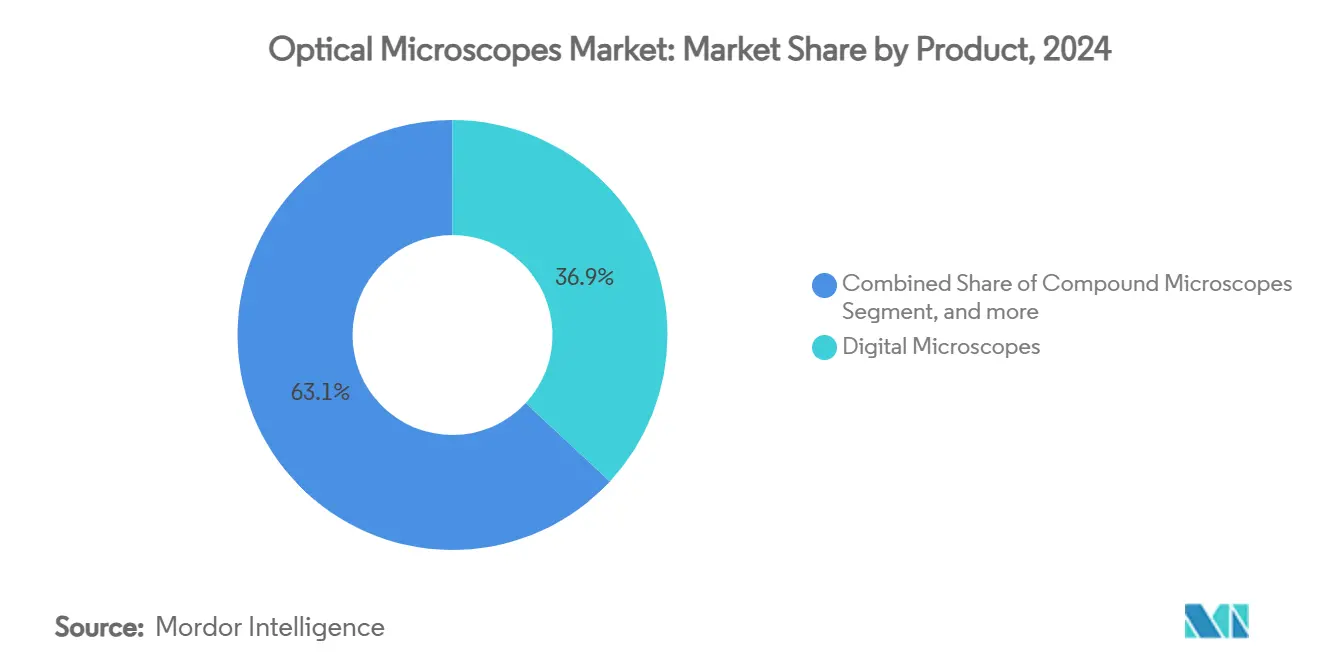
Note: Segment shares of all individual segments available upon report purchase
By End User: Academic Institutions Lead Adoption Patterns
Universities and government research centers constituted 42.81% of 2024 demand, bolstered by NIH’s annual spending shared instrumentation grants and dedicated center-of-excellence programs that underwrite multi-photon, confocal, and cryo-compatible rigs. Shared-core models stretch utilization beyond 80%, ensuring steady consumable and service streams for vendors. Diagnostic laboratories exhibit the fastest rise at an 8.81% CAGR, propelled by telepathology and digital worklists that cut slide logistics costs while expanding specialist reach. Hospitals embed point-of-care platforms to speed antimicrobial stewardship decisions and intraoperative margin assessments, further entrenching microscopes in frontline care pathways.
Pharmaceutical and biotech firms deploy high-content screening suites to profile drug-candidate libraries, pairing multiplexed fluorescence with AI-driven phenotype quantification. Industrial customers especially semiconductor and battery manufacturers install hybrid optical-Raman units to monitor defect densities and electrolytic degradation. Across these settings, the optical microscopes market size for enterprise-grade service contracts grows as uptime guarantees and AI-software licenses become central to procurement decisions. However, technician shortages compel vendors to bundle remote support and automated calibration, subtly reshaping revenue mixes away from hardware-only sales.
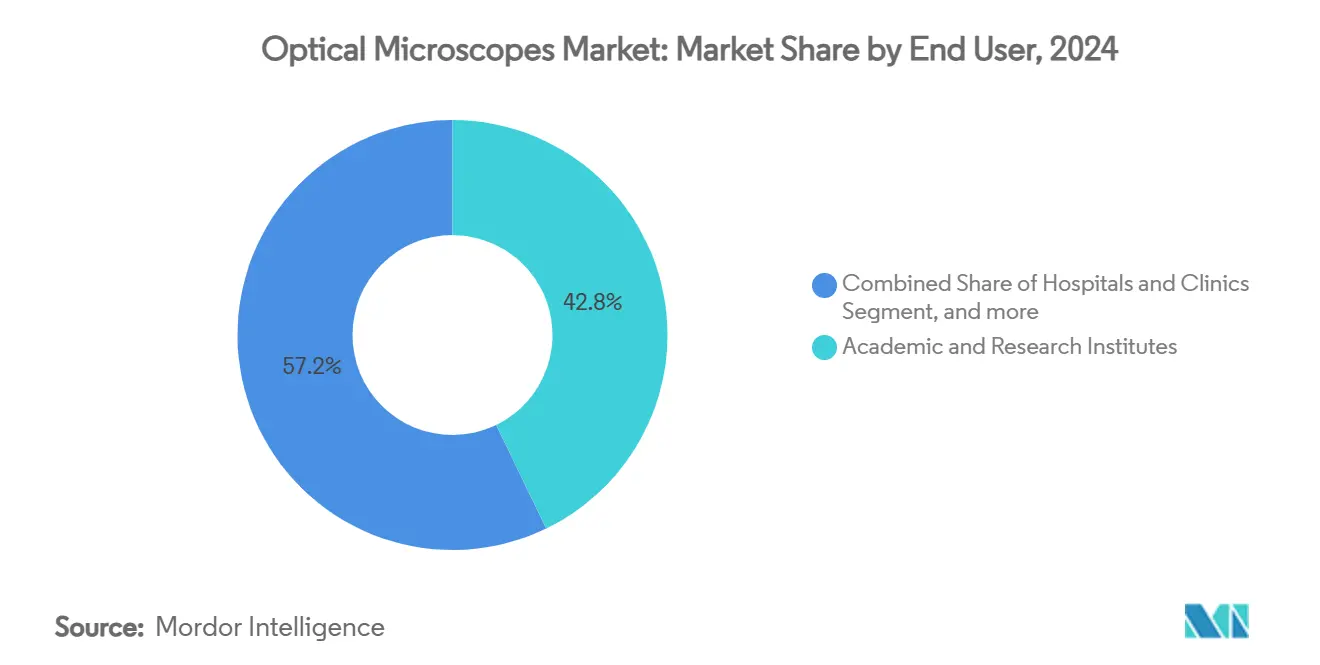
Note: Segment shares of all individual segments available upon report purchase
Geography Analysis
North America leads the optical microscopes market with a 34.13% revenue contribution in 2024, supported by NIH-funded cryo-EM hubs and well-established clinical pathology workflows. Yet chronic laboratory technologist shortages 46% vacancy reported in 2024 limit throughput, prompting hospitals to prioritize automation and integrated AI platforms. Digital pathology penetration rises as teleconsultation becomes standard, and market players package scanners, analytics, and cloud storage in subscription models that ensure predictable spending.
Asia Pacific is the fastest mover, expanding at an 11.09% CAGR through 2030. China’s provincial governments allocate multi-year budgets for tertiary-hospital upgrades that include multi-photon and quantum-sensor units, while India’s diagnostics sector, creating fertile ground for decentralized imaging. Suppliers accelerate localization ZEISS inaugurated a 13,000 square-meter R&D and manufacturing site in Suzhou to tailor optics and software for local protocols. Still, regulatory uncertainty and reimbursement lag in some markets introduce revenue recognition delays, encouraging vendors to adopt partnership-led go-to-market models.
Europe maintains balanced growth, buoyed by Horizon Europe research grants and a cohesive CE-mark framework that simplifies cross-border sales. Middle East & Africa and South America collectively account for a modest but accelerating slice of the optical microscopes market as governments emphasize healthcare self-sufficiency and academic collaborations with G7 institutions drive technology transfers.
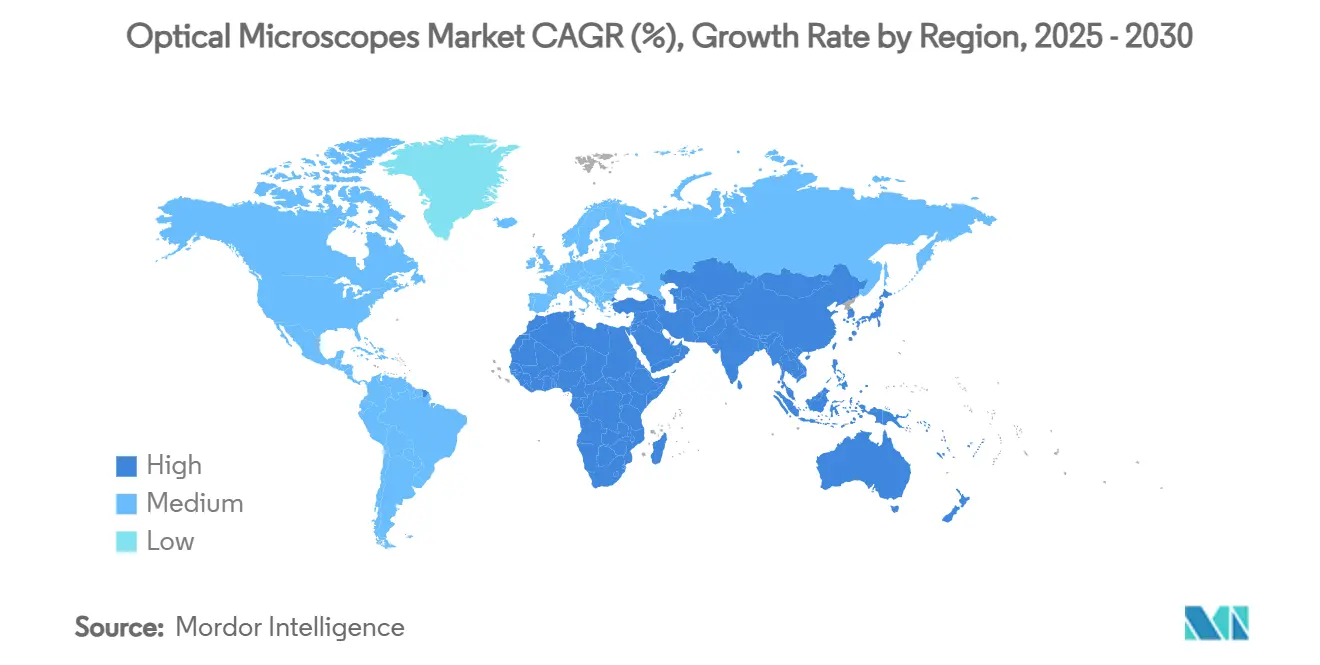
Competitive Landscape
The optical microscopes market exhibits moderate fragmentation, with legacy specialists defending premium tiers and emergent entrants leveraging computational know-how to undercut hardware costs. Carl Zeiss allocates 14% of revenue to R&D, channeling funds into quantum sensing and AI-enabled modules to sustain technical leadership. Leica Biosystems joined forces with Indica Labs, fusing Aperio scanners with HALO AP analytics to propose a turnkey digital pathology ecosystem. Thermo Fisher’s Vulcan Automated Lab integrates robotics with atomic-scale TEM metrology, illustrating convergence between optical and electron modalities to capture semiconductor demand.
Acquisition momentum continues: Quanterix’s planned integration of Akoya Biosciences positions the merged entity to offer blood- and tissue-based biomarker detection across a single workflow. Bruker’s nVista 2P miniature system complements its established multiphoton line, addressing in-vivo neuroscientists requiring sub-300-micron depth in freely moving animals. Meanwhile, open-source collectives threaten low- to mid-tier segments by releasing printable designs that replicate basic functionality for under USD 100, forcing incumbents to emphasize servicing networks, software subscriptions, and turnkey compliance.
Strategically, vendors pursue hybrid monetization: hardware sales bundle AI-grade GPUs, perpetual licenses convert to usage-based cloud fees, and predictive-maintenance contracts secure post-installation revenue. Supply-chain localization appears increasingly in boardroom agendas after pandemic-era shocks highlighted sourcing vulnerabilities. Market leadership will hinge on balancing cutting-edge optics with scalable analytics and end-user guidance as staffing constraints persist across global labs.
Optical Microscopes Industry Leaders
-
Carl Zeiss AG
-
Leica Microsystems
-
Meiji Techno
-
Nikon Instruments Inc.
-
Olympus Corporation
- *Disclaimer: Major Players sorted in no particular order
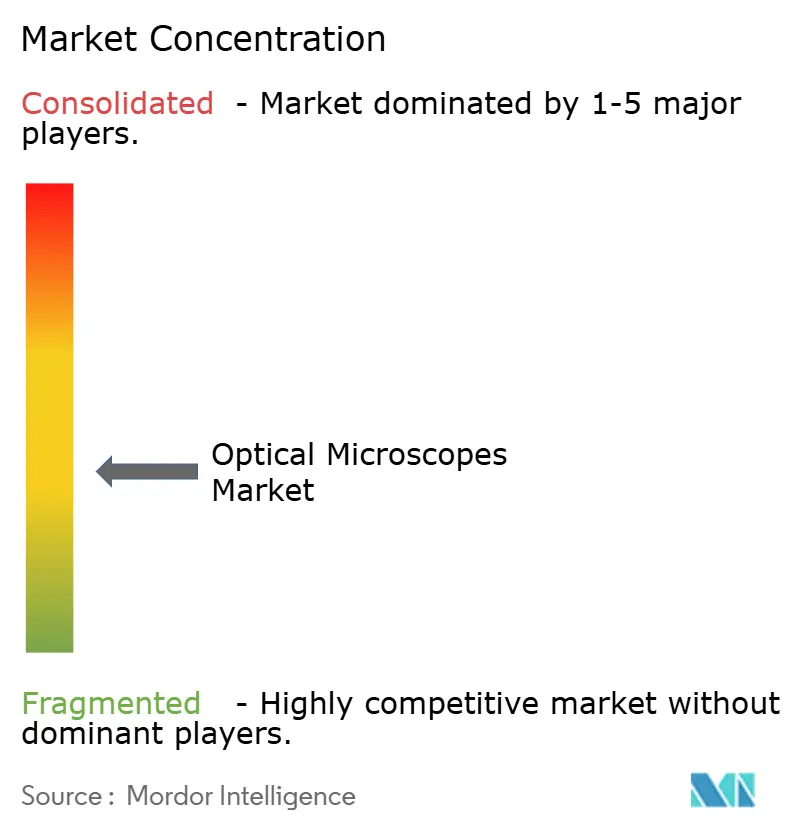
Recent Industry Developments
- June 2025: Thermo Fisher Scientific unveiled next-generation Orbitrap Astral Zoom and Orbitrap Excedion Pro mass spectrometers at ASMS 2025, offering 35% faster scan speeds and 50% expanded multiplexing capabilities to revolutionize biopharma applications and omics research. These innovations aim to accelerate discoveries in precision medicine and improve understanding of complex diseases like Alzheimer's and cancer
- May 2025: Bruker Corporation launched the timsMetabo mass spectrometer for breakthrough 4D-Metabolomics and 4D-Lipidomics, featuring TIMS-enabled small molecule analysis and Mobility Range Enhancement technology. The system supports high-precision quantification and real-time gas phase CCS ion separation, significantly advancing research in human metabolism and therapeutic strategies
- May 2025: Olympus Corporation received FDA clearance for its EZ1500 series endoscopes featuring Extended Depth of Field technology, enhancing image clarity for gastrointestinal procedures. The endoscopes integrate with the EVIS X1™ system and include advanced imaging technologies like Texture and Color Enhancement Imaging and Narrow Band Imaging
- April 2025: Bruker introduced the nVista 2P Miniature Microscope, a two-photon system designed for functional imaging of freely behaving animals. The lightweight system enables high-resolution imaging at depths up to 300 microns and integrates seamlessly with existing Inscopix systems for enhanced neuroscience research capabilities
Global Optical Microscopes Market Report Scope
As per the scope of the report, an optical microscope is a device that uses one lens or a series of lenses to magnify images of small samples with visible light. The Optical Microscopes Market is Segmented By Product (Digital Microscopes, Stereo Microscope, Inverted Microscopes, Other Products), End User (Hospitals and Clinics, Academic and Research Institutes, Diagnostics Laboratories, Other End Users), and Geography (North America, Europe, Asia-Pacific, Middle-East and Africa, and South America). The market report also covers the estimated market sizes and trends for 17 different countries across major regions, globally. The report offers the value (in USD million) for the above segments.
| Compound Microscopes |
| Stereo Microscopes |
| Digital Microscopes |
| Inverted Microscopes |
| Fluorescence & Super-Resolution Microscopes |
| Other Optical Microscopes |
| Hospitals & Clinics |
| Academic & Research Institutes |
| Diagnostic Laboratories |
| Pharmaceutical & Biotech Companies |
| North America | United States |
| Canada | |
| Mexico | |
| Europe | Germany |
| United Kingdom | |
| France | |
| Italy | |
| Spain | |
| Rest of Europe | |
| Asia Pacific | China |
| Japan | |
| India | |
| Australia | |
| South Korea | |
| Rest of Asia-Pacific | |
| Middle East & Africa | GCC |
| South Africa | |
| Rest of Middle East & Africa | |
| South America | Brazil |
| Argentina | |
| Rest of South America |
| By Product | Compound Microscopes | |
| Stereo Microscopes | ||
| Digital Microscopes | ||
| Inverted Microscopes | ||
| Fluorescence & Super-Resolution Microscopes | ||
| Other Optical Microscopes | ||
| By End User | Hospitals & Clinics | |
| Academic & Research Institutes | ||
| Diagnostic Laboratories | ||
| Pharmaceutical & Biotech Companies | ||
| By Geography | North America | United States |
| Canada | ||
| Mexico | ||
| Europe | Germany | |
| United Kingdom | ||
| France | ||
| Italy | ||
| Spain | ||
| Rest of Europe | ||
| Asia Pacific | China | |
| Japan | ||
| India | ||
| Australia | ||
| South Korea | ||
| Rest of Asia-Pacific | ||
| Middle East & Africa | GCC | |
| South Africa | ||
| Rest of Middle East & Africa | ||
| South America | Brazil | |
| Argentina | ||
| Rest of South America | ||
Key Questions Answered in the Report
What is the forecast value of the optical microscopes market by 2030?
The market is projected to reach USD 3.88 billion by 2030, growing at a 5.83% CAGR.
Which product segment is expanding the fastest?
Fluorescence and super-resolution platforms are advancing at a 7.56% CAGR on the back of nanometer-scale imaging breakthroughs.
Why is Asia Pacific considered the growth engine for optical microscopes?
Government-backed hospital upgrades in China and India’s med-tech roadmap underpin an 11.09% regional CAGR through 2030.
How are staffing shortages influencing purchasing decisions?
Laboratories with 46% technologist vacancies favor microscopes embedded with AI-driven automation to sustain throughput despite limited skilled labor.
What role does open-source hardware play in the market?
Printable optical components and community-shared designs reduce entry costs by up to 90%, broadening access and pressuring traditional pricing models.
Which strategic moves are major companies making?
Leaders such as Zeiss pour 14% of revenue into R&D, while Leica’s partnership with Indica Labs and Thermo Fisher’s Vulcan automation initiative illustrate a pivot toward integrated hardware-software ecosystems.
Page last updated on:
